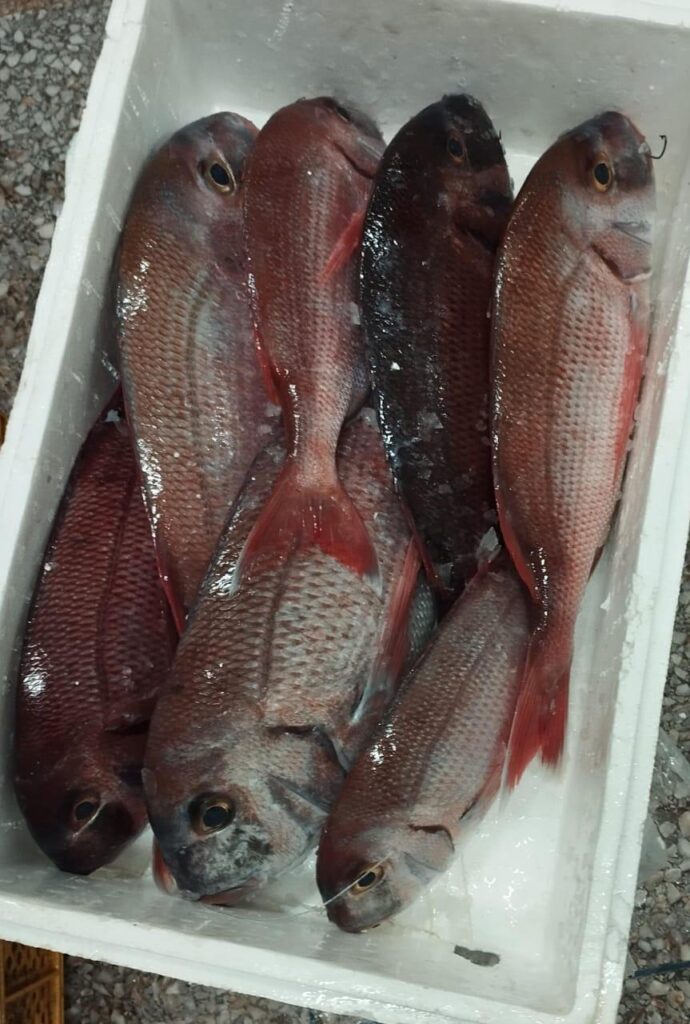The Pink Sea Bream, scientifically known as Pagellus bogaraveo, also commonly referred to as the Blackspot Sea Bream or Besugo, is a highly esteemed fish in Mediterranean cuisine and culture. Renowned for its delicate taste and firm texture, Pink Sea Bream enjoys popularity among seafood enthusiasts and culinary experts alike. This fish species, easily recognizable by its distinctive pinkish hue, occupies a significant role in regional seafood markets, particularly along the coasts of North Africa and Southern Europe. In this comprehensive guide, we explore the fascinating characteristics, habitat, culinary uses, nutritional value, and ecological considerations associated with Pink Sea Bream, highlighting why this fish remains a prized delicacy throughout Europe and North Africa.
 Identification and Physical Characteristics
Identification and Physical Characteristics
The Pink Sea Bream (Pagellus bogaraveo) belongs to the Sparidae family, commonly known as seabreams or porgies. It has a moderately elongated, oval-shaped body, featuring an attractive silver-pink to reddish coloration on its upper sides. Its body coloration fades gradually toward the belly, becoming lighter or silvery. Typically, adults measure between 20 and 40 cm, though larger specimens reaching lengths up to 70 cm have been documented. They possess a single dorsal fin with spiny rays and sharp fin rays, along with robust jaws well adapted for their omnivorous feeding habits.
The Pink Sea Bream primarily inhabits the Northeast Atlantic Ocean, extending from Norway down to Cape Blanc, including the Mediterranean Sea. They prefer moderate depths ranging from 40 meters to as deep as 300 meters. Juveniles tend to live closer to the shore, gradually migrating deeper as they mature. They inhabit rocky seabeds, sandy substrates, and occasionally seagrass areas, where they can find shelter and abundant food resources.
The diet of Pink Sea Bream is versatile, which contributes to its highly appreciated culinary qualities. It feeds mainly on smaller fish, crustaceans, mollusks, and occasionally on marine plants. Its diverse diet contributes significantly to its flavorful, tender flesh, prized by chefs for grilling, baking, or stewing.
The fish’s feeding habits reflect adaptability, allowing it to thrive in various marine environments. It employs a cautious hunting technique, typically consuming prey located near the seabed, demonstrating patience and efficiency in its predatory behavior.
The Pink Sea Bream’s culinary popularity stems largely from its exceptional taste and nutritional benefits. Its flesh is lean, high in protein, and enriched with beneficial nutrients, including omega-3 fatty acids, essential minerals like potassium and phosphorus, and vitamins such as Vitamin B12 and Vitamin D. This nutritional richness makes the Pink Sea Bream a highly recommended fish for health-conscious consumers, as part of a balanced and nutrient-dense diet.
The fish is versatile in culinary applications. Popular preparations include simple grilling with herbs and olive oil, baked in salt crust, or poached gently with Mediterranean seasonings. Mediterranean and North African cuisines often feature it alongside traditional ingredients such as garlic, olive oil, lemon, and aromatic herbs like rosemary and thyme.
Historically, Pink Sea Bream has held a prominent place in Mediterranean cooking traditions. Its presence in seafood dishes of Morocco, Spain, France, Italy, and Greece highlights its cultural significance. In Morocco, it frequently features in tagines and oven-roasted dishes accompanied by flavorful marinades and traditional spices such as cumin, paprika, garlic, and fresh cilantro.
From an ecological perspective, Pink Sea Bream plays a critical role in its marine habitat, contributing to the ecological balance by controlling populations of smaller fish and marine invertebrates. Overfishing and habitat degradation pose challenges, prompting concerns about sustainability and responsible fishing practices.
Conservation efforts have intensified recently due to overfishing pressures. Regulatory measures, such as quotas and seasonal restrictions, have been enacted in various European and Mediterranean countries to ensure sustainable management of Pink Sea Bream populations. Ensuring responsible fishing practices is essential for maintaining its availability for future generations.
Aquaculture has also started contributing significantly to the availability of Pink Sea Bream in global markets. Fish farms, particularly in the Mediterranean basin, cultivate this species in controlled marine environments. Farm-raised Pink Sea Breams often maintain high quality and consistency, helping meet consumer demand while reducing pressure on wild populations. Nevertheless, discerning consumers often distinguish between wild-caught and farmed specimens, with wild catches generally perceived as superior in taste and texture.
Conservationists and marine biologists regularly monitor Pink Sea Bream populations to assess the impacts of fishing and environmental changes. The goal is to balance commercial interests with ecological sustainability, thereby safeguarding marine biodiversity.
For consumers interested in freshness, selecting Pink Sea Bream with clear, bright eyes, firm flesh, and a clean ocean scent is crucial. Proper storage and quick consumption after purchase help preserve the fish’s qualities, as its flavor and texture diminish rapidly when freshness is compromised.
As consumer demand for high-quality seafood grows, particularly in regions emphasizing fresh, local, and responsibly sourced products, Pink Sea Bream holds a promising future. Its appeal, rooted in both its culinary potential and nutritional benefits, positions it as an increasingly favored choice among seafood lovers worldwide.
In summary, the Pink Sea Bream stands out not only for its taste and versatility but also for its nutritional value and ecological significance. Embracing sustainable fishing practices and responsible consumption habits will help preserve this exceptional species for culinary and ecological purposes, ensuring continued enjoyment of its unique flavors and benefits for generations to come.